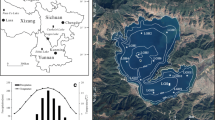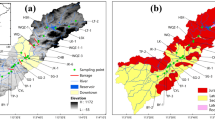Abstract
Detailed magnetic measurements and geochemical analyses were performed on 114 sediment samples collected from the East Lake, Wuhan city, China, to establish a possible link between the enhanced concentration of anthropogenic magnetic particles and heavy metals with known sources. Relatively higher magnetic susceptibility values (mass-specific, χ, >150 × 10−8 m3 kg−1) were observed for samples near the pollution sources: e.g. the Wuhan Iron and Steel Company (WISC), the Qingshan Thermal Power Plant (QTPP), the banks (driveways) of the lake and near the sightseeing route of yachts on the lake. Moreover, χ is positively correlated to the concentration of Pb (correlation coefficient r = 0.682), but negatively or weakly correlated with both Zn and Cu. In contrast, anhysteretic remanent magnetization (ARM) is significantly correlated with these major heavy metals (r = 0.645 for Zn–ARM, 0.699 for Pb–ARM and 0.841 for Cu–ARM, respectively), which indicate that ARM serves a better indicator for the pollution of heavy metals in this lake. Thermomagnetic analysis combined with magnetic hysteresis measurements revealed that magnetites in the pseudo-single-domain/multidomain grain-size regions are dominant. Scanning electron microscopy and energy dispersive X-ray examinations of the magnetic extracts showed that these Fe-rich particles have different morphologies: orange-peel structure, hollow structure with adhered smaller particles, Zr-rich melted-like irregular particles, pear-shaped spherules and spherules with slick surfaces. These features are typical for particles produced by anthropogenic activities. Because of the genetic relationship between the environmental setting of the East Lake and the nearby pollution sources, this study suggests that in situ magnetic surveys are sensitive to evaluate the environmental pollution on the lake bottom.








Similar content being viewed by others
References
Beckwith PR, Ellis JB, Revitt DM, Oldfield F (1986) Heavy metals and magnetic relationships for urban source sediments. Phys Earth Planet Inter 42:67–75
Chan LS, Ng SL, Davis AM, Yim WWS, Yeung CH (2001) Magnetic properties and heavy-metal contents of contaminated seabed sediments of Penny’s bay, Hong Kong. Mar Pollut Bull 42:569–583
Chaparro MAE, Bidegain JC, Sinito AM, Gogorza CSG, Jurado S (2003) Preliminary results of magnetic measurements on stream-sediments from Buenos Aires Province, Argentina. Stud Geophys Geod 47:121–145
Chaparro MAE, Bidegain JC, Sinito AM, Jurado SS, Gogorza CSG (2004) Magnetic studies applied to different environments (soils and stream sediments) from a relatively polluted area in Buenos Aires Province, Argentina. Environ Geol 45:654–664
Chaparro MAE, Lirio JM, Nunez H, Gogorza CSG, Sinito AM (2005) Preliminary magnetic studies of lagoon and stream sediments from Chascomus area (Argentina)—magnetic parameters as indicators of heavy metal pollution and some results of using an experimental method to separate magnetic phases. Environ Geol 49:30–43
Charlesworth SM, Lees JA (1997) The use of mineral magnetic measurements in polluted urban lakes and deposited dusts, Coventry, U.K. Phys Chem Earth 22(1–2):203–206
China Environmental Monitoring Station (1990) Background values of elements in soils of China. China Environmental Press, Beijing (in Chinese)
Cornell RM (1991) Simultaneous incorporation of Mn, Ni and Co in the goethite (α-FeOOH) structure. Clay Miner 26:427–430
Day R, Fuller M, Schmidt V (1977) Hysteresis properties of titanomagnetites: grain-size and compositional dependence. Phys Earth Planet Inter 13:260–267
Desenfant F, Petrovský E, Rochette P (2004) Magnetic signature of industrial pollution of stream sediments and correlation with heavy metals: case study from South France. Water Air Soil Pollut 152:297–312
Emiroglu S, Rey D, Petersen N (2004) Magnetic properties of sediment in the Ria de Arousa (Spain): dissolution of iron oxides and formation of iron sulphides. Phys Chem Earth 29:947–959
Georgeaud VM, Rochette P, Ambrosi JP, Vandamme D, Williamson D (1997) Relationship between heavy metals and magnetic properties in a large polluted catchment: the Etang de Berre (South of France). Phys Chem Earth A 22:211–214
Hanesch M, Scholger R (2002) Mapping of heavy metal loadings in soils by means of magnetic susceptibility measurements. Environ Geol 42:857–870
Hoffmann V, Knab M, Appel E (1999) Magnetic susceptibility mapping of roadside pollution. J Geochem Explor 66:313–326
Hu S, Wang Y, Appel E, Zhu Y, Hoffmann V, Shi C, Yu Y (2003) Magnetic responses to acidification in Lake Yangzonghai, SW China. Phys Chem Earth 28:711–717
Huang KM, Lin S (2003) Consequences and implication of heavy metal spatial variations in sediments of the Keelung River drainage basin, Taiwan. Chemosphere 53:1113–1121
Hullet LD, Weinberger AJ, Northcutt KJ, Ferguson M (1980) Chemical species in fly ash from coal-burning power plant. Science 210:1356–1358
Jain CK, Ram D (1997) Adsorption of lead and zinc on bed sediments of the river Kali. Water Res 31(1):154–162
Jordanova D, Hoffmann V, Fehr KT (2004) Mineral magnetic characterization of anthropogenic magnetic phases in the Danube river sediments (Bulgarian part). Earth Planet Sci Lett 221:71–89
Kapička A, Jordanova N, Petrovský E, Podrazský X (2003) Magnetic study of weakly contaminated forest soils. Water Air Soil Poll 148:31–44
Knab M, Hoffmann V, Petrovský E, Kapička A, Jordanova N, Appel E (2005) Surveying the anthropogenic impact of the Moldau river sediments and nearby soils using magnetic susceptibility. Environ Geol. doi: 10.1007/s00254-005-0080-5
Kukier U, Fauziah Ishak C, Summer ME, Miller WP (2003) Composition and element solubility of magnetic and non-magnetic fly ash fractions. Environ Pollut 123:255–266
Liu QS, Banerjee SK, Jackson MJ, Maher BA, Deng CL, Pan YX, Zhu RX (2004) Mechanism of the magnetic susceptibility enhancements of the Chinese loess. J Geophys Res 109:B12107. doi:10.1029/2004JB003249
Locke G, Bertine KK (1986) Magnetic sediments as an indicator of coal combustion. Appl Geochem 1:345–356
Lottermoser BG (2002) Mobilization of heavy metals from historical smelting slag dumps, North Queensland, Australia. Miner Mag 66:475–490
Lu SG, Bai SQ, Cai JB, Xu C (2005) Magnetic properties and heavy metal contents of automobile emission particulates. J Zhejiang Univ Sci 6B(8):731–735
Magiera T, Strzyszcz Z (2000) Ferrimagnetic minerals of anthropogenic origin in soils of some Polish national parks. Water Air Soil Pollut 124:37–48
Maher BA, Thompson R, Hounslow MW (1999) Introduction. In: Maher BA, Thompson R (eds) Quaternary climates, environments and magnetism. Cambridge University Press, Cambridge, pp 1–48
McLennan AR, Bryant GW, Stanmore BR, Wall TF (2000) Ash formation mechanism during combustion in reducing conditions. Energy Fuels 14:150–159
Mullins CE (1977) Magnetic susceptibility of the soil and its significance in soil science—a review. J Soil Sci 28:223–246
Oldfield F, Hunt A, Jones MDH, Chester R, Dearing JA, Olsson L, Prospero JM (1985) Magnetic differentiation of atmospheric dusts. Nature 317:516–518
Olson KW, Skogerboe RK (1975) Identification of soil lead compounds from automotive sources. Environ Sci Technol 9:227–230
Peters C, Dekkers MJ (2003) Selected room temperature magnetic parameters as a function of mineralogy, concentration and grain size. Phys Chem Earth 28:659–667
Peters C, Thompson R (1998) Magnetic identification of selected natural iron oxides and sulphides. J Magn Magn Mater 183:365–374
Petrovský E, Ellwood B (1999) Magnetic monitoring of air, land and water pollution. In: Maher BA, Thompson R (eds) Quaternary climates, environments and magnetism. Cambridge University Press, Cambridge, pp 279–322
Petrovský E, Kapička A, Zapletal K, Sebestova E, Spanila T, Dekkers MJ, Rochette P (1998) Correlation between magnetic parameters and chemical composition of lake sediments from Northern Bohemia—preliminary study. Phys Chem Earth 23(9–10):1123–1126
Petrovský E, Kapička A, Jordanova N, Knab M, Hoffmann V (2000) Low-field magnetic susceptibility: a proxy method of estimating increased pollution of different environmental systems. Environ Geol 39:312–318
Petrovský E, Kapička A, Jordanova N, Boruvka L (2001) Magnetic properties of alluvial soils contaminated with lead, zinc and cadmium. J Appl Geophys 48:127–136
Plater AJ, Ridgway J, Appleby PG, Berry A, Wright MR (1998) Historical contaminant fluxes in the Tees Estuary, UK: geochemical, magnetic and radionuclide evidence. Mar Pollut Bull 37:343–360
Roberts AP (1995) Magnetic properties of sedimentary greigite (Fe3S4). Earth Planet Sci Lett 134:227–236
Roberts AP, Weaver R (2005) Multiple mechanisms of remagnetization involving sedimentary greigite (Fe3S4). Earth Planet Sci Lett 231:263–277
Roberts AP, Cui Y, Verosub KL (1995) Wasp-waisted hysteresis loops: mineral magnetic characteristics and discrimination of components in mixed magnetic systems. J Geophys Res 100(B9):17909–17924
Rose AW, Bianchi-Mosquera GC (1993) Adsorption of Cu, Pb, Zn, Co, Ni and Ag on goethite and hematite: a control on metal mobilization from red beds into stratiform copper deposits. Econ Geol 88:1226–1236
Rose NL, Boyle JF, Du Y, Yi C, Dai X, Appleby PG, Bennion H, Cai S, Yu L (2004) Sedimentary evidence for changes in the pollution status of Taihu in the Jiangsu region of eastern China. J Paleolimnol 32:41–51
Schmidt A, Yarnold R, Hill M, Ashmore M (2005) Magnetic susceptibility as proxy for heavy metal pollution: a site study. J Geochem Explor 85:109–117
Scholger R (1998) Heavy metal pollution monitoring by magnetic susceptibility measurements applied to sediments of the river Mur (Styria, Austria). Eur J Environ Eng Geophys 3:25–37
Sokol EV, Kalugin V, Nigmatulina E, Volkova N, Frenkel A, Maksimova N (2002) Ferrospheres from fly ashes of Chelyabinsk coals: chemical composition, morphology and formation conditions. Fuel 81:867–876
Strzyszcz Z, Magiera T (2001) Record of industrial pollution in Polish ombrotrophic peat bogs. Phys Chem Earth A 26(11–12):859–866
Tauxe L, Mullender TAT, Pick T (1996) Potbellies, wasp-waists, and superparamagnetism in magnetic hysteresis. J Geophys Res 101:571–583
Taylor RM, Maher BA, Self PG (1987) Magnetite in soils. I. The synthesis of superparamagnetic and single domain magnetite. Clay Miner 22:411–422
Theis TL, Wirth JL (1977) Sorptive behavior of trace metals on fly ash in aqueous systems. Environ Sci Technol 11:1096–1100
Thompson R, Bloemendal J, Dearing JA, Oldfield F, Rummery TA, Stober JC, Turner GM (1980) Environmental applications of magnetic measurements. Science 207:481–486
Torii M, Fukuma K, Horng CS, Lee TQ (1996) Magnetic discrimination of pyrrhotite and greigite bearing sediment samples. Geophys Res Lett 23(14):1813–1816
Versteeg JK, Morris WA, Rukavina NA (1995) The utility of magnetic properties as a proxy for mapping contamination in Hamilton Harbor sediments. J Great Lakes Res 21:71–83
Wehland F, Panaiotu C, Appel E, Hoffmann V, Jordanova D, Jordanova N, Denut I (2002) The dam breakage of Baia Mare—a pilot study of magnetic screening. Phys Chem Earth 27:1371–1376
Acknowledgments
This study was supported by the National Natural Science Foundation of China (No. 40474025). We thank Dr Q.S. Liu for improving the language and the anonymous reviewers for their helpful comments.
Author information
Authors and Affiliations
Corresponding author
Rights and permissions
About this article
Cite this article
Yang, T., Liu, Q., Chan, L. et al. Magnetic signature of heavy metals pollution of sediments: case study from the East Lake in Wuhan, China. Environ Geol 52, 1639–1650 (2007). https://doi.org/10.1007/s00254-006-0609-2
Received:
Accepted:
Published:
Issue Date:
DOI: https://doi.org/10.1007/s00254-006-0609-2




